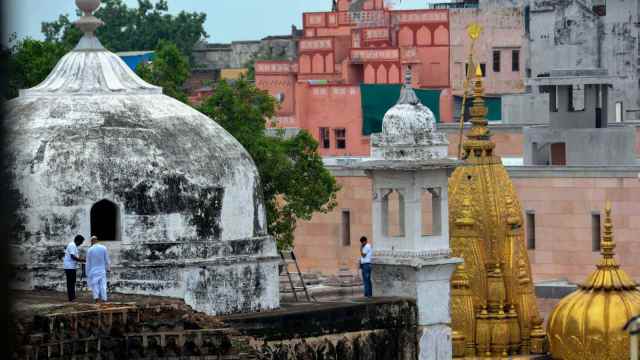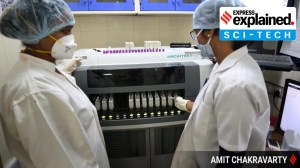- India
- International
Gyanvapi case: ASI says ‘there existed large Hindu temple prior to construction’
“Based on scientific studies/survey carried out, study of architectural remains, exposed features and artefacts, inscriptions, art and sculptures, it can be said that there existed a Hindu temple prior to the construction of the existing structure,” reads the ASI report.
 A Varanasi court on Wednesday ruled that the ASI report on the Gyanvapi mosque complex survey will be given to both sides while making it clear that the report should not be made public, the counsel for the Hindu litigants said. (PTI Photo)
A Varanasi court on Wednesday ruled that the ASI report on the Gyanvapi mosque complex survey will be given to both sides while making it clear that the report should not be made public, the counsel for the Hindu litigants said. (PTI Photo)The Archaeological Survey of India (ASI), tasked by the Varanasi district court in July 2023 to conduct a scientific survey of the Gyanvapi mosque complex, has concluded that “there existed a Hindu temple prior to the construction of the existing structure” at the site.
Hindu litigants have claimed that the mosque was built on the site of the original Kashi Vishwanath temple after its destruction in the 17th century.
The ASI, which was tasked to ascertain whether the mosque was “constructed over a pre-existing structure of a Hindu temple”, submitted its report to the court last month in a sealed cover. Its copies were handed Thursday by the court to Hindu and Muslim litigants in matters related to the dispute over the site.
The report stated: “Based on scientific studies/survey carried out, study of architectural remains, exposed features and artefacts, inscriptions, art and sculptures, it can be said that there existed a Hindu temple prior to the construction of the existing structure.”
“The Arabic-Persian inscription found inside a room mentions that the mosque was built in the 20th regnal year of Aurangzeb (1667-77). Hence, the pre-existing structure appears to have been destroyed in the 17th century, during the reign of Aurangzeb and part of it was modified and reused in the existing structure,” it stated.

“Existing architectural remains, decorated mouldings, on the walls, karna-ratha and prati-ratha of central chamber, a large decorated entrance gate, with Torana on the eastern wall of the western chamber, a small entrance with mutilated image of lalatabimba, birds and animals carved for decoration in and outside suggest that the western wall is remaining part of a Hindu temple. Based on art and architecture, this pre-existing structure can be identified as a Hindu temple.”
“Sculptures of Hindu deities and carved architectural members were found buried under the dumped soil in cellar S2.” The report stated that “pillars from earlier temples were reused while making cellars in the eastern part of the platform”.
“A pillar decorated with bells, niches for keeping lamps on all four sides, and bearing an inscription of Samvat 1669 (corresponding to 1613 CE, January 1, Friday) is reused in cellar N2,” it stated.
“A series of cellars were also constructed to the east to create additional space and a large platform in front of the mosque for accommodating a large number of people for prayers,” it stated.
The “ASI had in its custody record of an inscription engraved on a loose stone which recorded construction of the mosque in the 20th regnal year of Hadrat Alamgir i.e. Mughal Emperor Aurangzeb corresponding to A.H. 1087 (1676-77 CE). The inscription also recorded that in the year A.H. 1207 (1792-93 CE), the mosque was repaired with sahan, etc. The photograph of this stone inscription was recorded in ASI records in the year 1965-66,” it stated.
“During the recent survey, this stone with inscription was recovered from a room in the mosque. However, the lines relating to construction of the mosque and its expansion have been scratched out,” it stated.
“This is also brought out by the biography of Emperor Aurangzeb, Maasir-i-Alamgiri, which mentions that Aurangzeb ‘issued orders to the governors of all provinces to demolish the schools and temples of the infidels’ (Jadunath Sarkar tr 1947, Maasir-i-Alamgiri, pp 51-52). On September 2, 1669; ‘it was reported that, according to the Emperor’s command his officers had demolished the temple of Vishwanath at Kashi’ (Jadunath Sarkar (tr.) 1947 Maasir-i-Alamgiri p.55),” it stated.
The ASI said that “during the survey, a number of inscriptions were noticed on the existing and pre-existing structures. A total of 34 inscriptions were recorded during the present survey and 32 estampages were taken”.
“These”, it said “are, in fact, inscriptions on the stones of the pre-existing Hindu temples, which have been re-used during the construction/ repair of the existing structure. They include inscriptions in Devanagari, Grantha, Telugu and Kannada scripts. Reuse of earlier inscriptions in the structure, suggest that the earlier structures were destroyed and their parts were reused in construction/ repair of the existing structure”.
The report pointed out that “three names of deities such as Janärdhana, Rudra, and Umesvara are found in these inscriptions. Terms such as Maha-muktimandapa mentioned in three inscriptions are of great significance”.
Under the headline “pillars and pilasters”, the report stated, “The pillars and pilasters used in the existing structure were studied systematically and scientifically. For the enlargement of the mosque and constructing sahan, parts of the pre-existing temple including pillars and pilasters were reused with little modifications. Minute studies of the pillars and pilasters in the corridor suggest that they were originally part of the pre-existing Hindu temple. For their reuse, in the existing structure, Vyala figures carved on either side of lotus medallion were mutilated and after removing the stone mass from the corners that space was decorated with floral design. This observation is supported by two similar pilasters still existing on the northern and southern wall of the western chamber in their original place.”
The report stated that “all the objects which were noticed during the scientific survey in the complex were duly noted”.
“These objects include inscriptions, sculptures, coins, architectural fragments, pottery, and objects of terracotta, stone, metal and glass. Objects that required first aid treatment were treated at the site,” it stated. These objects were then handed over to the district administration in compliance with the court order, the report stated.
May 07: Latest News
- 01
- 02
- 03
- 04
- 05





























